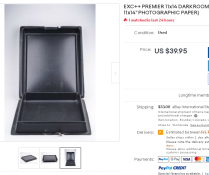blockend
Member
Anselholics AnonymousAlbert Ainstein?
Anselholics AnonymousAlbert Ainstein?
No - the stop bath prevents that.
The advantage is that you can turn on the lights and actually start seeing what you are doing once the stop bath has done its job.
I wouldn't do this with a water stop. A very small amount of development probably continues for a short while even after the film is in the fixer.How effective would a water stop bath be after Pyrocat-DH development -- good enough for the lights, or wait until the film hits the fixer? (open trays, 11x14 film) Thx...
PS...I remember AA recommending somewhere to make sure the stop bath was used at its full normal working strength (for prints).
Bad idea, Vaughn. Remember that a water stop bath works relatively slowly by simply diluting/washing the developer out, not chemically stopping the developer. Development does not stop immediately. So if the lights are on, exposing the film or paper, while development is slowing down but still happening...
There are a lot of people who find it difficult to handle film in total darkness without daylight tanks. This cuts down on the difficulty.

I don't know about Kodak or Ilford, but Phil Davis certainly did - it is standard procedure with BTZS tubes.Same here. Seems like a pretty needless risk but that’s just my own two cents. On the other hand I don’t know of any darkroom workers who purposely turn the lights on at the stop stage either. Did Kodak or Ilford ever recommend it?

Bad idea, Vaughn. Remember that a water stop bath works relatively slowly by simply diluting/washing the developer out, not chemically stopping the developer. Development does not stop immediately. So if the lights are on, exposing the film or paper, while development is slowing down but still happening...
The issue isn't light exposure. It is developer carry-over.
The exposure doesn't matter if there aren't any reducing agents left in the mix. Subsequently exposed silver halides will just get fixed away without effect.
Assuming of course that the light exposure isn't so long and intense as to cause printing out.
Obviously there is induction time - which is yet another variable not known by the user. I'm sorry but this is just a potential risk/problem for no particular reason. It's a darkroom. You've developed in the dark, which is the majority of the time. You can't wait an extra 30 seconds for the stop bath and maybe 1-2 minutes for preliminary fixing? And even if you absolutely can't wait, it has to be full room lights on?
So whose engine will last longer if they use an acidic stop bath first?
I would suggest that if you take a print or film from and alkali solution and then put it in a near neutral pH solution (water) and then turn on the lights you may introduce a level of fog. This maybe not visible to the eye, but could raise base fog. Has anyone tested this by experimenting lights before and after fix using a densitometer?
Using pyro developers, I unload a sheet out of the 11x14 holder behind me with one hand wearing a glove. I can't grab the sheet out of the holder with a gloved hand...need my fingernails. I set the film on top of the holder, get the other glove on, grab the film and into either a water bath or straight into the developer, depending on how I am feeling. When using Ilford Universal PQ developer, I might skip the gloves. Then a water stop for the pyro developer and an acid bath for the PQ developer.
I like an acid bath with the PQ developer...kinda of nice to know I have neutralized the base completely and my fingers are not slippery anymore.
Using pyro developers, I unload a sheet out of the 11x14 holder behind me with one hand wearing a glove.


FWIW, I don't open my daylight tanks until I am at least half way through fixing, and usually not until the end of the fixing stage.Obviously there is induction time - which is yet another variable not known by the user. I'm sorry but this is just a potential risk/problem for no particular reason. It's a darkroom. You've developed in the dark, which is the majority of the time. You can't wait an extra 30 seconds for the stop bath and maybe 1-2 minutes for preliminary fixing? And even if you absolutely can't wait, it has to be full room lights on?
You probably have two hands that are capable of handling sheet film. I'm limited to one plus a non-dexterous second.If there is no other way (BTZS for example), I guess you have to, but sheet/tray development - I'm not buying that one. Gathering the sheets and transferring to the stop bath, then doing the same to transfer to the fixer, that's just part of tray development of sheet film. Small space, tiny space. I'd honestly never before heard of anyone purposely turning the lights on before at least partial fixation, but that was before this thread...
| Photrio.com contains affiliate links to products. We may receive a commission for purchases made through these links. To read our full affiliate disclosure statement please click Here. |
PHOTRIO PARTNERS EQUALLY FUNDING OUR COMMUNITY:  |